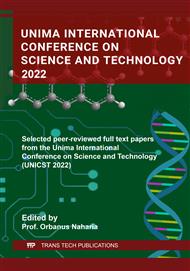p.39
p.49
p.55
p.63
p.73
p.83
p.93
p.101
p.111
Metal Analysis of Pb, Fe, Cd with Activated Carbon Material in Tondano Watershed, East Kombos Area, Manado City
Abstract:
This study aimed to determine the characteristics of activated charcoal from mangroves resulting from pyrolysis and activation with 3M KCl using Fourier Transform Infra-Red (FTIR), X-Ray Diffraction (XRD) and ash content analysis and to determine the ratio of Pb, Fe and Cd metal content in river water before and after filtered with activated charcoal. The results of the FTIR test for charcoal from mangroves resulting from pyrolysis and activation with KCl showed the presence of O-H, C=C, C-H, C-N and C-Cl groups as additional groups that appeared after the activation process. The results of XRD analysis show that the lattice parameter (α) can be calculated, namely in pyrolysis mangrove charcoal = 5.79 and charcoal from pyrolysis and activation mangrove wood = 5.88. The results show that there is a change in the distance between the crystal planes after activation, with the known value of, the results of d-spacing 3 strong peaks are 3.39 , 2.94 and 5.88 . The results of the analysis of the ash content are 15.4% and exceed the maximum percentage that has been determined, because there are still impurities attached to the carbon surface. The results of the analysis using Atomic Absorbtion Spectrophotometry (AAS) showed that there were differences in the levels of Pb, Fe and Cd in river water before and after being filtered with activated charcoal. There was a decrease in Pb levels from points 1,2 and 3 as much as 73%, 49% and 55.23%. Meanwhile, Fe metal decreased from points 1, 2 and 3 as much as 58%, 66% and 81%. And on Cd there was a decrease of 44%, 61% and 92%. From these percentage results, activated charcoal from mangroves can be said to be effective because it can absorb metals in river water. Pb metal in river water in East Kombos Manado City has passed the concentration specified in Government Regulation of the Republic of Indonesia No. 22 of 2021, Class II Water Quality Standards.
Info:
Periodical:
Pages:
73-81
Citation:
Online since:
July 2023
Keywords:
Price:
Сopyright:
© 2023 Trans Tech Publications Ltd. All Rights Reserved
Share:
Citation:


